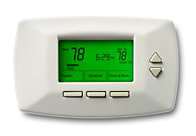Your Thermostat: Myths and Truths

January 24, 2012
For being such a little instrument, thermostats play a pretty big role in your overall comfort and the cost of heating and cooling your home. Consider the following thermostat myths and facts when you use your thermostat. Doing so may just help you maximize the benefits you get from controlling your indoor comfort.
Myth:
Your furnace or air conditioner has to work much harder to warm or cool a space to a comfortable temperature after the thermostat has been set back, meaning you really aren’t saving all that much on energy costs.
Fact:
If the temperature is set at energy saving set points for longer periods of time during the day when no one is home or at night after bedtime, a significant amount of energy and/or fuel is saved over letting the unit run to maintain the desired comfortable temperature. Years of research have proven energy savings are achieved between the time the temperature stabilizes at the set back temperature and the next time the heat or air conditioning is needed. The longer your home remains at the set back temperature, the more energy you will save.
Myth:
The higher you raise the temperature for heat or the lower you set it for air conditioning, the faster your house will reach this temperature.
Fact:
Cranking your unit down super low to say, 55 degrees, or a super high 90 degrees will not cool or heat your home any faster. Heat pumps and air conditioners put out the same amount of heat or conditioned air regardless of the thermostat setting. The determining factor is how long it takes to reach the set temperature, not how high or how low the thermostat is set.
Myth:
If your house isn’t being cooled or heated to a comfortable temperature, despite the thermostat settings, the thermostat must be broken.
Fact:
More often than not, when your home isn’t reaching the desired temperature, it is not the thermostat to blame. Instead, the issue could be with the heating or cooling system or possibly a problem with your ductwork. If you're experiencing this issue, you should contact a professional who can accurately diagnose the problem and offer the appropriate repair solutions.
Myth:
The location of the thermostat is not that important to its ability to function properly.
Fact:
The location of your thermostat is very important. Its environment can significantly influence its performance, which in turn, influences your comfort and the cost of keeping you comfortable. Thermostats should be placed away from doorways, direct sunlight, drafty areas, drapery, appliances, vents, registers, and the kitchen. Ideally, thermostats should be installed in a convenient location and most closely to areas requiring optimal comfort control such as the bedrooms.
Myth:
No home really needs more than one thermostat.
Fact:
Even smaller homes can benefit from having more than one thermostat. Especially homes with multiple heating or cooling zones such as downstairs living space and upstairs bedrooms, multiple thermostats can help you maximize your energy savings and improve your overall comfort.
Understanding how to use your thermostat correctly can help you save a lot on energy costs and greatly improve your comfort control. If you are in the market for a new thermostat or have questions about getting the most out of what yours has to offer, contact a qualified HVAC contractor to help. Especially when it comes to installation of a new thermostat, proper calibration is key.
To learn more about operating your thermostat, purchasing a new thermostat and more, contact Florida’s heating and cooling experts, Cool Today.
Posted in: Tips